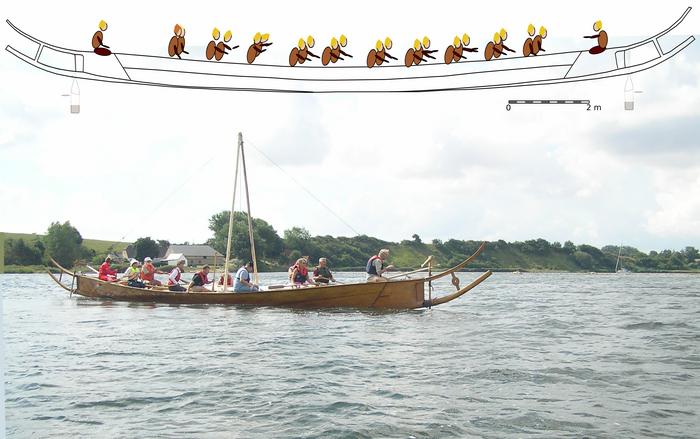In a groundbreaking study published on April 2, 2025, in the prestigious open-access journal PLOS One, researchers unveiled compelling evidence suggesting that inhabitants of Bronze Age-era Denmark had the ability to navigate the open sea directly to Norway. The study, led by Dr. Boel Bengtsson from the University of Gothenburg and her esteemed colleagues, utilized an innovative computer modeling tool designed to replicate ancient maritime journeys. This approach not only enriches our understanding of seafaring practices in ancient Scandinavia but also paves the way for further explorations of historical maritime navigation.
Archaeological findings have long indicated cultural and technological similarities between Bronze Age societies in northern Denmark and southwestern Norway. These two regions share a wealth of artifacts, burial practices, and architectural styles, suggesting a deep-rooted connection. Historically, it has been assumed that maritime trade and cultural exchange primarily occurred along coastal routes, constituting a 700-kilometer journey that hugged the Scandinavian shores. The tantalizing question of whether these ancient peoples ventured into the open ocean directly—over 100 kilometers of treacherous waters—has remained largely speculative until now.
To explore this possibility, Dr. Bengtsson and her team embarked on a comprehensive study employing advanced computational modeling techniques aimed at simulating maritime journeys using a historically significant vessel: the Hjortspring boat. This large paddle-driven canoe, dated back to around 350 BCE, was reconstructed through meticulous analysis of archaeological remains. By incorporating variables such as ocean currents, wind patterns, and vessel maneuverability, the researchers created a multifaceted simulation that could emulate various maritime scenarios faced by Bronze Age navigators.
The results of their simulations were astonishing, indicating that ancient mariners possessed not only the capability but potentially the necessity to undertake direct journeys across open waters. These simulations revealed the remarkable adaptability and resilience of seafarers, demonstrating their ability to contend with diverse environmental challenges. Key to these voyages would be enhanced navigational skills, an understanding of weather patterns, and the capability to pilot vessels adept in handling waves of up to one meter high and winds reaching speeds of 10 knots. The study emphasized that while these open-water crossings were possible, they were likely confined to the summer months when conditions were most favorable.
In stark contrast to the notion of open-sea navigation, the coastal route, though safer and viable year-round, would have required extensive time—often comprising several weeks—because of the need for regular stops to replenish supplies. This dichotomy highlights the intricate calculations ancient mariners had to make when deciding on a route: the risks versus the rewards of direct ocean crossings compared to the lengthy, yet safer, coastal alternative.
The significance of this research transcends merely shedding light on ancient maritime capabilities. The methodological framework established by Bengtsson and her colleagues lays a foundation for future explorations of ancient seafaring across different cultures and time periods. Their innovative modeling program can be adapted to study a wide array of vessels, provided sufficient data regarding hull shape and specifications are available.
The implications of these findings are immense, echoing through the realms of archaeology, anthropology, and maritime history. By demonstrating the potential for regular open-sea crossings in the northern European waters, the authors indirectly assert that Bronze Age societies were much more interconnected than previously understood. This research invites a reevaluation of the seafaring networks that existed thousands of years ago, highlighting the sophistication of navigation and boat construction techniques that enabled ancient peoples to brave the open waters.
Moreover, the study reflects a crucial step towards bridging the gaps in our understanding of prehistoric cultural exchange and social dynamics. The prospect that ancient Danish navigators frequently traversed the open sea to connect with Norwegian communities presents a different narrative of cultural dissemination, suggesting that maritime mastery played a critical role in shaping regional identities during this transformative era.
Dr. Bengtsson and her collaborators conclude their research by asserting the significance of their agent-based simulations in revealing the historical interplay between technology, navigation, and environmental understanding during the Bronze Age. The potential for rekindling interest in ancient maritime practices opens up avenues for interdisciplinary collaboration, urging scholars from various fields to converge and unravel the complexities of human adaptation to maritime environments.
As our understanding of ancient seafaring continues to evolve, it is imperative for historians and archaeologists to utilize such models not only to reconstruct the past but also to further comprehend contemporary challenges related to navigation, climate change, and our approach to marine resources. The ancient lessons etched across seas and waterways offer timeless insights into human ingenuity and resilience.
In sharing their findings, the research team has not only contributed a significant chapter to the historiography of ancient navigation but has also underscored the importance of continued interdisciplinary research. The echoes of the past, as illuminated by modern technology, remind us of our shared heritage and the unending quest for knowledge about those who sailed before us.
The study stands as a testament to how technological advances in modeling and simulation can unlock new narratives about our ancestors’ capabilities. Through the lens of modern science, the lives of Bronze Age mariners are brought back to life, revealing their remarkable spirit of exploration that echoes timelessly across the currents of history.
Subject of Research: Seafaring and navigation in the Nordic Bronze Age
Article Title: Seafaring and navigation in the Nordic Bronze Age: The application of an ocean voyage tool and boat performance data for comparing direct open water crossings with sheltered coastal routes
News Publication Date: April 2, 2025
Web References: DOI
References: Bengtsson B, Montenegro A, Green A, Tomasini M, Prince M, Skärström VW, et al. (2025) Seafaring and navigation in the Nordic Bronze Age: The application of an ocean voyage tool and boat performance data for comparing direct open water crossings with sheltered coastal routes. PLoS ONE 20(4): e0320791.
Image Credits: Photo by Knut Valbjørn.




